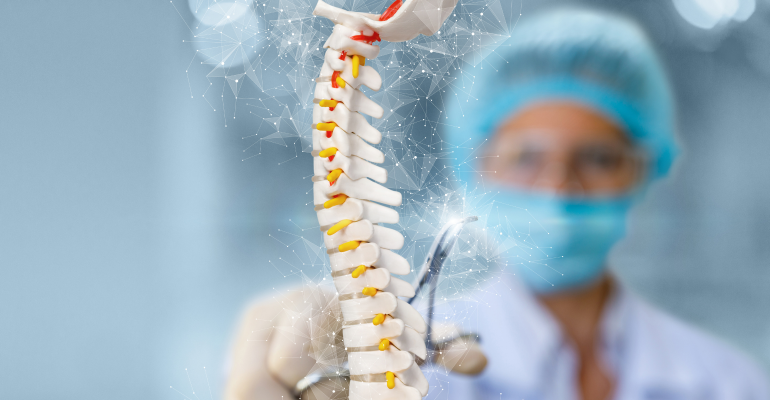Over the past decade, the use of robots to assist in surgical procedures has increased significantly. Robotic surgery has become widespread in a wide range of medical specialties, including general surgery, urology, and gynaecology. The use of robots in spine surgery has only recently been explored. Pedicle screw placement is a common procedure in spine surgery, which can be aided using robotic technology. Misplacement of the pedicle screw can result in serious complications such as neurologic or vascular injury, so there is little room for error in this procedure. Drilling with a robotic system requires an accuracy level at least on par with that of currently used screw placement techniques like free-hand drills, fluoroscopy, and computed tomography (CT).
A growing body of research has documented early results demonstrating the robotic systems' equal accuracy and lower radiation exposure when compared with other methods of screw placement.
According to the World Health Organisation, between 250,000 and 500,000 people worldwide suffer a spinal cord injury each year, often resulting in life-changing loss of sensory and motor function. Up to 90 per cent of these cases are the result of traumatic events. Preliminary Mayo Clinic research indicates that stem cells derived from a patient's own fat can help people with spinal cord injuries improve their motor and sensory function.

In an interview with neurosurgeon clinician-scientist, Mohamad Bydon, M.D., Mayo clinic we spoke about how robotic spine surgery can improve existing methods and research conducted by Mayo Clinic on how using stem cells is a step toward improving motor, sensory function after spinal cord injury.
Dr. Bydon has an interest in studying clinical bioinformatics and serves as Medical Director of the Mayo Clinic Neurosurgical Biobank and Clinical Registry, which compiles prospective data on clinical outcomes of neurosurgical procedures. He also serves as the director of the Mayo Clinic Neuro-Informatics Laboratory, using big data to define the cost and value of medical and surgical interventions.
The use of robotic systems to aid in surgical procedures has greatly increased over the past decade. Is this prevalence necessary and needed?
The use of robotics in surgical procedures is rising across surgical specialties. The evidence behind the value of robotics in improving patient care and surgical workflow is well-documented, and the indications of robotic-assisted surgery are expanding. Robotics is not a panacea, but there are several surgical procedures in which a benefit has been proven. In these cases, the rise in robotic-assisted surgery is justified, and it should be further enhanced. The research to improve its applications and expand its indications is also necessary to enhance patient care.
What are the benefits of robotic spine surgery for practitioners and patients?
The high accuracy and the minimal invasiveness of robotic spine surgery are its two main contributions to patient care. The accuracy offers multiple, well-controlled manipulations. In the case of spine surgery, that means well-placed screws that serve as anchors to the rod, giving stability to the patient. The less invasive nature allows for small surgical wounds, minimal manipulation of the muscles that support the spine, and, therefore, quick return to mobility for the patient and discharge from the hospital.
Robotic systems must provide a degree of accuracy comparable to that of already-established methods of screw placement, can you elaborate on this statement?
In fact, robotic systems aim to improve the degree of accuracy of the already-established surgical methods. Prior to robotic-assisted surgery, most interventions in surgery relied on a combination of imaging and free-hand manipulations. The robotic systems empower contemporary surgical techniques by combining imaging with the precision and reproducibility that the robotic arms offer. Overall, robotic surgery aims to minimize the unavoidable error margin that free-hand manipulations entail.
How does stem cell treatment support patients in recovery for spinal cord injury? What are the next steps in stem cell treatment after spinal cord injury?
Stem cells are the cornerstone of regenerative medicine, and several applications of stem cells are being investigated across a broad spectrum of patient needs. In spinal cord injury, stem cells therapy is hypothesised to influence the intrathecal environment towards a regeneration-permissive state that facilitates the formation of new blood vessels and nerve structures. Outside spinal cord injury, regenerative medicine has demonstrated promising outcomes in dementia and stroke. Nevertheless, all these hypotheses — including spinal cord injury — are still under investigation, and the role of stem cells in clinical practice remains to be determined.
Can you speak about Mayo Clinic’s Case report: Stem cells a step toward improving motor, sensory function after spinal cord injury, what have the findings highlighted?
This case report presented outcomes of the first patient who was enrolled in our phase 1 clinical trial investigating the role of stem cells in spinal cord injury. The foundations for this clinical trial were laid for years before the publication of these findings via multiple experiments that documented promising results. As in all phase 1 clinical trials, the primary goal of this trial was to demonstrate the safety of the treatment. However, our first patient also responded impressively to the treatment, showing significant improvement in his neurological status. At the moment, a phase 2 clinical trial is being conducted by our team.


